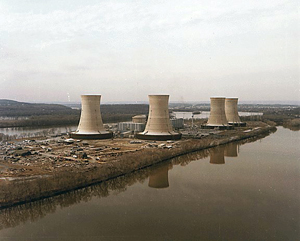et NUCLEAIRES
THREE MILE ISLAND
2009: 30 ans après...
ADIT, http://www.irsn.fr/, http://www.sciam.com/


|
27/03/2009
Le 28 mars 1979, à la centrale nucléaire
de Three Mile Island en Pennsylvanie (Etats-Unis), une série de
défaillances matérielles et humaines provoquaient la fusion
partielle du cœur du réacteur nucléaire.
Consulter le dossier sur l'accident de Three Mile Island et ses enseignements pour la sûreté des centrales nucléaires en France. Télécharger le rapport Accidents graves des réacteurs à eau de production d'électricité.* http://www.sciam.com/ Once a majestic symbol of nuclear power, the plant would become synonymous with its dangers after one of its two reactors—the newer one, known as Unit 2—nearly melted down on March 28, 1979, just months after it was fired up. |
The plant was shuttered, and Pennsylvania
Gov. Richard Thornburgh recommended that pregnant women and preschoolers
within five miles (eight kilometers) of the plant evacuate; some nearby
hospitals and nursing homes were also evacuated. Today steam billows from
the chunky, twin cooling towers of TMI's only functioning unit; the crippled
reactor, now a skeleton, never reopened.
The incident triggered an outcry of protest against nuclear power, with critics pointing to the possible risks, including the lack of safety measures and workable evacuation plans. When Chernobyl in Ukraine, then a republic in the Soviet Union, melted down seven years later in what would become the worst nuclear power plant disaster in history, it seemed like the death knell for the industry—at least in the U.S. Who could ever have predicted that the tide would turn? Yet three decades later, 20-plus applications have been filed for permission to construct new U.S. nuclear power plants—and even some onetime critics have done an about-face. The reason: Nuclear is (NOT!) one of the carbon-free alternatives to coal-fired and other fossil-fueled power, which result in greenhouse gas emissions responsible for global warming. And when they weigh climate change against the potential of another nuclear accident, they find the former the greater threat—especially in light of stiffer safety regulations adopted since the TMI incident. Citizens' groups still worry that nuclear plants provide tempting targets for would-be terrorists—and that there are no credible evacuation plans should a facility—such as Indian Point in the Hudson River just 24 miles (38 kilometers) north of New York City—melt down. But time—and a pressing global environmental threat—seem to have erased much of the opposition to nuclear power, paving the way for the renaissance of an industry once believed fatally wounded in the U.S. For more on the Three Mile Island accident—and the past, present and future of nuclear power, see our in-depth report on the power-generating technology. And for more on the Three Mile Island cleanup, see our feature on the robots that did much of the work. |